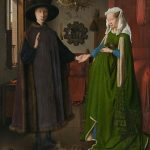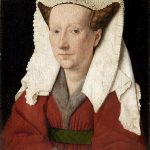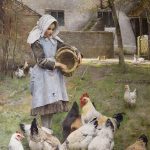In the vibrant tapestry of the Northern Renaissance, Jan van Eyck stands out as a master of detail, light, and realism. His works have captivated audiences for centuries, none more so than the enigmatic “Arnolfini Portrait.” This painting, rich with symbolism and meticulous detail, has sparked endless debate and admiration. Central to this masterpiece is the speculation that the female figure might be none other than van Eyck’s own wife, Margaret van Eyck. This article delves into their lives, the creation of the “Arnolfini Portrait,” and the legacy they left behind, exploring how their relationship might have influenced this iconic work.
The Lives of Jan and Margaret van Eyck
Jan van Eyck was born around 1390 in the region that is now Belgium. Very little is known about his early life, but by 1422, he was working in The Hague, serving John III the Pitiless, ruler of Holland. By 1425, van Eyck had moved to Bruges, where he became court painter to Philip the Good, Duke of Burgundy. This position not only provided financial stability but also connected him with the intellectual and cultural elite of the time.
Jan van Eyck’s skills were unparalleled. He was a pioneer in the use of oil paint, which allowed for greater detail and richer colors than the tempera used by his contemporaries. His works are characterized by their meticulous attention to detail, vibrant color palette, and masterful use of light and shadow.
Margaret van Eyck, his wife, remains a somewhat enigmatic figure in art history. Little is documented about her life, background, or even her exact birth and death dates. What is known, however, is that she married Jan van Eyck around 1432, during the height of his career. The marriage is believed to have been a happy and supportive one, with Margaret playing a significant role in van Eyck’s life and possibly his work.
The couple had at least two children, and Jan’s affection for Margaret is evident in his works and the way he signed his paintings. It was rare for artists of the time to include personal references in their work, but van Eyck often signed with phrases like “Als ich kan” (As I can), suggesting a personal motto or a private joke shared between them.
The Arnolfini Portrait: A Masterpiece of Mystery
The “Arnolfini Portrait,” painted in 1434, is one of van Eyck’s most famous and studied works. The painting depicts a man and a woman standing in the center of a room, holding hands. The room is filled with intricate details: a chandelier, a convex mirror reflecting the couple and two other figures, a bed, a small dog, and various household items, each meticulously rendered. The painting is a tour de force of van Eyck’s skill, showcasing his mastery of light, texture, and perspective.
The subjects of the painting have long been debated. Traditionally, it has been believed to depict Giovanni di Nicolao di Arnolfini, a wealthy Italian merchant, and his bride. However, the exact identities of the couple, the nature of the scene, and the symbolism within the painting remain topics of scholarly debate.
One intriguing theory is that the female figure in the painting is actually Margaret van Eyck. This hypothesis arises from the intimate nature of the portrait and the attention to detail in depicting the woman. Van Eyck’s skill in rendering fabrics, textures, and human features suggests a level of familiarity and affection that might indicate a personal connection.
Supporters of this theory point to the mirror in the background, which reflects not only the couple but also two other figures, one of whom might be van Eyck himself. The inclusion of these figures and the signature “Johannes de Eyck fuit hic 1434” (Jan van Eyck was here 1434) suggest that the artist intended to make a personal statement with this work.
Margaret van Eyck: Muse and Partner
If Margaret was indeed the woman in the “Arnolfini Portrait,” what does this tell us about her role in Jan’s life and work? Historical records provide limited information about Margaret, but her potential presence in one of Jan’s most famous works speaks volumes about their relationship.
Margaret’s role as a muse and partner to Jan van Eyck would have been significant. During the Renaissance, women were often portrayed in art, but rarely were they given a voice or recognized for their influence on the artists themselves. If Margaret was the model for the “Arnolfini Portrait,” it indicates a level of respect and admiration from Jan that was unusual for the time.
Their marriage, occurring around 1432, coincided with some of Jan’s most productive years. The stability and support provided by Margaret could have contributed to his ability to focus on his work and push the boundaries of his art. The emotional bond between them might have inspired the tenderness and detail with which Jan portrayed the female figure in the “Arnolfini Portrait.”
Moreover, the painting itself is filled with symbols of domestic life and marriage, from the dog symbolizing fidelity to the elaborate bed and the single lit candle in the chandelier, often interpreted as a symbol of marital unity. These elements could reflect not just the subjects of the painting but also Jan’s own views on marriage and his relationship with Margaret.
Legacy and Influence
The legacy of Jan van Eyck and his potential muse, Margaret, extends far beyond their lifetimes. Jan van Eyck’s innovations in oil painting and his meticulous attention to detail influenced countless artists and helped to define the Northern Renaissance. His works are studied for their technical mastery, their symbolic complexity, and their insights into 15th-century life.
If Margaret van Eyck was indeed the model for the “Arnolfini Portrait,” her legacy is immortalized in one of the most famous paintings in art history. Her presence in the painting adds a personal dimension to the work, reminding viewers that behind every great artist is often a network of support and inspiration. The possibility that Margaret was more than just a passive subject but an active participant in Jan’s creative process challenges traditional narratives about women’s roles in art history.
The “Arnolfini Portrait” itself has been the subject of extensive analysis and interpretation. Art historians have explored its symbolism, its technical aspects, and its historical context, making it one of the most analyzed paintings of all time. Theories about the identity of the subjects, the meaning of the various objects, and the purpose of the painting continue to evolve, reflecting the enduring fascination with this masterpiece.
Jan van Eyck’s attention to detail and his use of oil paints set new standards for realism in art. His techniques allowed for greater precision and luminosity, which became hallmarks of the Northern Renaissance style. Artists like Albrecht Dürer, Hans Holbein, and even later, the Dutch Masters, were influenced by van Eyck’s innovations.
For Margaret, the possibility of being the subject of such a significant work offers a unique perspective on her life and her relationship with Jan. It highlights the often-overlooked contributions of women to the arts, not just as subjects but as integral parts of the creative process. Her potential role in the “Arnolfini Portrait” invites us to reconsider the narratives of art history and acknowledge the collaborative nature of artistic creation.
In conclusion, the story of Jan and Margaret van Eyck, intertwined with the mystery of the “Arnolfini Portrait,” is a testament to the power of art to capture the complexities of human relationships. Whether Margaret was the model for the painting or not, the possibility enriches our understanding of their lives and their legacy. The “Arnolfini Portrait” remains a masterpiece of the Northern Renaissance, a symbol of artistic innovation, and a window into the personal and professional worlds of one of history’s greatest artists. Through this exploration, we gain a deeper appreciation for the individuals behind the art and the enduring impact of their contributions to the cultural heritage of the world.




